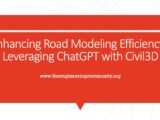
How AI can help in Highways and Railways design?
7 October 2023Table of Contents
How AI can help in Highways and Railways design?
Introduction:
Artificial Intelligence (AI) has emerged as a transformative technology across various industries, and its potential in revolutionizing transportation infrastructure design is no exception. Highways and railways are critical components of our transportation systems, and optimizing their design is crucial for efficiency, safety, and sustainability. In this article, we will explore how AI can play a significant role in enhancing the design process of highways and railways, leading to smarter, more efficient, and safer transportation networks.
1. Traffic Flow Analysis:
AI can analyze vast amounts of traffic data to gain insights into traffic patterns, congestion hotspots, and peak hours.Machine learning algorithms help transportation engineers make informed decisions about highway and rail design, such as: determine the optimal number of lanes, design efficient intersections and plan future expansions. This data-driven approach helps reduce congestion, improve traffic flow, and increase overall transportation efficiency.
2. Predictive Maintenance:
AI-based predictive maintenance systems can monitor the condition of highways and railways in real time. By analyzing sensor data such as vibration, temperature and wear patterns, AI algorithms can detect potential problems before they become critical.This proactive approach enables timely maintenance and repairs, minimizing inconvenience and ensuring the safety of commuters. Additionally, AI can optimize maintenance schedules, reducing costs and maximizing the lifespan of infrastructure assets.
3. Intelligent traffic management:
Artificial intelligence can enable intelligent traffic management systems that dynamically adapt to changing traffic conditions. By integrating real-time data from various sources such as road cameras, sensors and GPS devices, AI algorithms can optimize the timing of traffic lights, reroute vehicles in traffic jams and provide drivers with real-time traffic information. These AI-based systems can significantly reduce travel time, increase safety and improve the overall travel experience.
4.Simulation and optimization:
Artificial intelligence can simulate and optimize the design of highways and railways, taking into account various factors such as terrain, environmental impact and cost. Using artificial intelligence algorithms, engineers can generate multiple design scenarios, evaluate their performance, and identify the most efficient and sustainable options. This approach helps reduce construction costs, minimize environmental impact and ensure the long-term sustainability of transport infrastructure.
5. Improved security measures:
Artificial intelligence can improve security measures on highways and railways by analyzing data in real time and detecting potential threats.For example, computer vision algorithms can monitor traffic cameras and detect dangerous driving behavior such as speeding or lane violations. AI can also scan railway tracks for defects or obstacles, thereby detecting and preventing accidents at an early stage. By using artificial intelligence technologies, transportation authorities can proactively respond to safety issues and reduce the risk of accidents.
Conclusion:
Integrating artificial intelligence into the design and management of highways and railways has the potential to revolutionize transportation infrastructure. Using artificial intelligence algorithms, engineers can make data-driven decisions, optimize traffic flow, improve safety measures, and reduce maintenance costs.As artificial intelligence continues to develop, we can expect new innovations in transportation design that will lead to smarter, more efficient and more sustainable highways and railways. Integrating artificial intelligence into the design of transport infrastructure is not only a necessity, but also an important step towards building a sustainable transport network.


